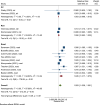Noise causes cardiovascular disease: it's time to act
- PMID: 39658622
- PMCID: PMC11876066
- DOI: 10.1038/s41370-024-00732-4
Noise causes cardiovascular disease: it's time to act
Abstract
Background: Chronic transportation noise is an environmental stressor affecting a substantial portion of the population. The World Health Organization (WHO) and various studies have established associations between transportation noise and cardiovascular disease (CVD), such as myocardial infarction, stroke, heart failure, and arrhythmia. The WHO Environmental Noise Guidelines and recent reviews confirm a heightened risk of cardiovascular incidents with increasing transportation noise levels.
Objective: We present a narrative review of the evidence from epidemiologic studies and translation studies on the adverse cardiovascular effects of transportation noise.
Methods: We describe the results of a recent Umbrella+ review that combines the evidence used in the 2018 WHO Environmental Noise Guidelines with more recent (post-2015) high-quality systematic reviews of original studies. High-quality systematic reviews were included based on the quality of literature search, risk of bias assessment, and meta-analysis methodology using AMSTAR 2.
Results: Epidemiologic studies show that exposure to high levels of road traffic noise for several years lead to numerous adverse health outcomes, including premature deaths, ischemic heart disease (IHD), chronic sleep disturbances, and increased annoyance. Mechanistically, noise exposure triggers oxidative stress, inflammation, endothelial dysfunction, and circadian rhythm disruptions. These processes involve the activation of NADPH oxidase, mitochondrial dysfunction, and nitric oxide synthase uncoupling, leading to vascular and cardiac damage. Studies indicate that chronic noise exposure does not result in habituation, and susceptible individuals, such as those with pre-existing CVD, are particularly vulnerable.
Keywords: Epidemiology; Exposure assessment; Health studies; Human well-being; Meta-analysis; Noise pollution.
© 2024. The Author(s).
Conflict of interest statement
Competing interests: The authors declare no competing interests. Ethical approval: Ethical approval was not required for this manuscript. Data used were obtained from the published literature. No data were directly obtained from human subjects.
Figures




Similar articles
-
Transportation noise and the cardiometabolic risk.Atherosclerosis. 2025 Apr;403:119148. doi: 10.1016/j.atherosclerosis.2025.119148. Epub 2025 Feb 24. Atherosclerosis. 2025. PMID: 40055082 Review.
-
Adverse Cardiovascular Effects of Traffic Noise with a Focus on Nighttime Noise and the New WHO Noise Guidelines.Annu Rev Public Health. 2020 Apr 2;41:309-328. doi: 10.1146/annurev-publhealth-081519-062400. Epub 2020 Jan 10. Annu Rev Public Health. 2020. PMID: 31922930 Review.
-
Transportation Noise Pollution and Cardiovascular Health.Circ Res. 2024 Apr 26;134(9):1113-1135. doi: 10.1161/CIRCRESAHA.123.323584. Epub 2024 Apr 25. Circ Res. 2024. PMID: 38662856 Review.
-
Cardiovascular effects of environmental noise exposure.Eur Heart J. 2014 Apr;35(13):829-36. doi: 10.1093/eurheartj/ehu030. Epub 2014 Mar 9. Eur Heart J. 2014. PMID: 24616334 Free PMC article. Review.
-
Too Loud to Handle? Transportation Noise and Cardiovascular Disease.Can J Cardiol. 2023 Sep;39(9):1204-1218. doi: 10.1016/j.cjca.2023.02.018. Epub 2023 Feb 28. Can J Cardiol. 2023. PMID: 36858080 Review.
References
-
- Munzel T, Sorensen M, Hahad O, Nieuwenhuijsen M, Daiber A. The contribution of the exposome to the burden of cardiovascular disease. Nat Rev Cardiol. 2023;20:651–69. - PubMed
-
- Hoffmann B, Moebus S, Stang A, Beck EM, Dragano N, Mohlenkamp S, et al. Residence close to high traffic and prevalence of coronary heart disease. Eur Heart J. 2006;27:2696–702. - PubMed
-
- Munzel T, Molitor M, Kuntic M, Hahad O, Roosli M, Engelmann N, et al. Transportation noise pollution and cardiovascular health. Circ Res. 2024;134:1113–35. - PubMed
Publication types
MeSH terms
LinkOut - more resources
Full Text Sources

